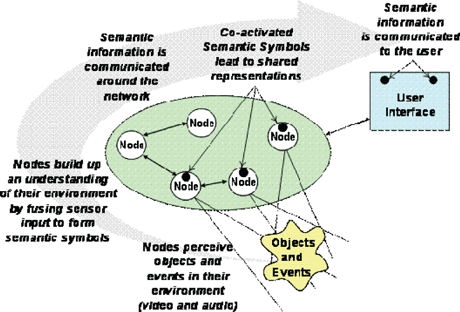by Wolfgang Herzner
The SENSE project (Smart Embedded Network of Sensing Entities) is developing methods, tools and a test platform for the design, implementation and operation of smart adaptive wireless networks of stationary embedded sensing components. The network is an ambient intelligent system, which adapts to its environment and delivers reliable information to its component sensors and the user.
SENSE is an EC-funded project of the 6th Framework Programme, Embedded Systems (objective 2.5.3, contract no. 33279). It aims at developing a platform for smart adaptive wireless networks of smart sensors. These sensors cooperate to establish and maintain a coherent global view from local information. Newly added nodes automatically calibrate themselves to the environment, and share knowledge with their neighbours. The network is scalable due to the local processing and sharing of information, and self-organizes based on the physical placement of nodes.
As test platform for a civil security monitoring system, a test application composed of video cameras and microphones, was chosen. The test platform will be installed at the Krakow Balice airport, to yield real data and performance goals from a realistic test environment. Each sensor is a stand-alone system consisting of multiple embedded components: video system, audio system, central processor, power source and wireless networking. The security application implements object/scenario recognition (eg unattended luggage or people 'lurking' in an area). Nodes recognize local objects, using a combination of video and audio information, and neighbouring nodes exchange information about objects in a self-organizing network. The result is a global overview of current objects and events observed by the network (see Figure 1).

The five main objectives are:
- to build networked systems of embedded components that can dynamically and automatically reconfigure themselves
- to convert low-level local information to semantic knowledge
- to use semantic-level knowledge for network-centric computation
- to understand how a shared semantic vocabulary influences dynamic node discovery and configuration
- to understand how perception and information processing can be combined using low-level and high-level feature fusion.
The expected results of SENSE are to combine the aspects of:
- embedded intelligent middleware in smart devices
- adaptive configuration
- flexible cooperation (among devices)
- high-level perception and adaptation
- dynamic networking in a common framework of semantic knowledge discovery and sharing.
The SENSE system encompasses aspects including:
- construction of a modality-neutral embedded test platform
- raw sensory processing
- transformation of sensory data into semantic knowledge
- communication between nodes to produce a consistent world view
- sharing of knowledge between intelligent nodes
- automatic recognition of unusual and alarm situations
- communication between the intelligent network and an operator, and
- automatic discovery and configuration of new intelligent nodes.
Embedded systems in SENSE develop their own semantic symbols based on an analysis of their environment. SENSE incorporates research from machine learning to discover statistical regularities in its environment, and compresses these regularities into informative semantic symbols. At the local level, SENSE uses algorithms such as 'expectation-maximization' to optimize each node's set of semantic symbols. Sharing of knowledge between nodes is also a topic of research, both in distributed systems and artificial intelligence. The SENSE system uses a mature algorithm called 'belief propagation'. This algorithm specifies how to share probability distributions over semantic concepts between nodes, such that a self-consistent world view results. Figure 2 illustrates the architecture of SENSE.

The unique feature of SENSE is that it combines technology from embedded systems, robotics, networking and machine learning research in a new way. The result is a framework for the development of smart networks of embedded components that are flexible, adaptive and device-independent. Networks that cover those challenges are called ad hoc networks or self-organizing networks. Their development is driven by the wireless community, but some of their principles are also of interest for wired networks. Less effort is required for their installation, initialization and maintenance, and they display inherent fault tolerance and the possibility to save energy within the network. This is true for both wired and wireless types but is typically only relevant for the latter. In contrast to self-organizing networks, traditional networks have a very time-demanding commissioning phase that also involves expert knowledge.
Dynamic addition or removal of nodes is a further challenge. In ad hoc networks, connections are constantly created and destroyed. This is called 'plug and participate'.
Vision and audio sensors were selected to fit the application domain and also because they are complex enough to allow for significant advancement in sensor processing technology. However, the framework designed will be generic enough to accommodate a wide range of sensors. The middleware and software framework is designed to easily incorporate additional sensor types, which mean the project results are more easily extended and the technology is easier to adopt for third parties.
With respect to requirements, the airport application is very similar to other applications in public buildings and public areas, such as shopping centres, railway and bus stations, office buildings, football stadiums and so on. The SENSE technology is modular and is appropriate for integration with existing security systems (existing video systems, for example). This provides an upgrade path from current systems to a full distributed SENSE system, improving the chances for technology uptake.
Link:
http://www.sense-ist.org
Please contact:
Wolfgang Herzner
Austrian Research Centers - ARC (AARIT)
E-mail: wolfgang.herzner![]() arcs.ac.at
arcs.ac.at










